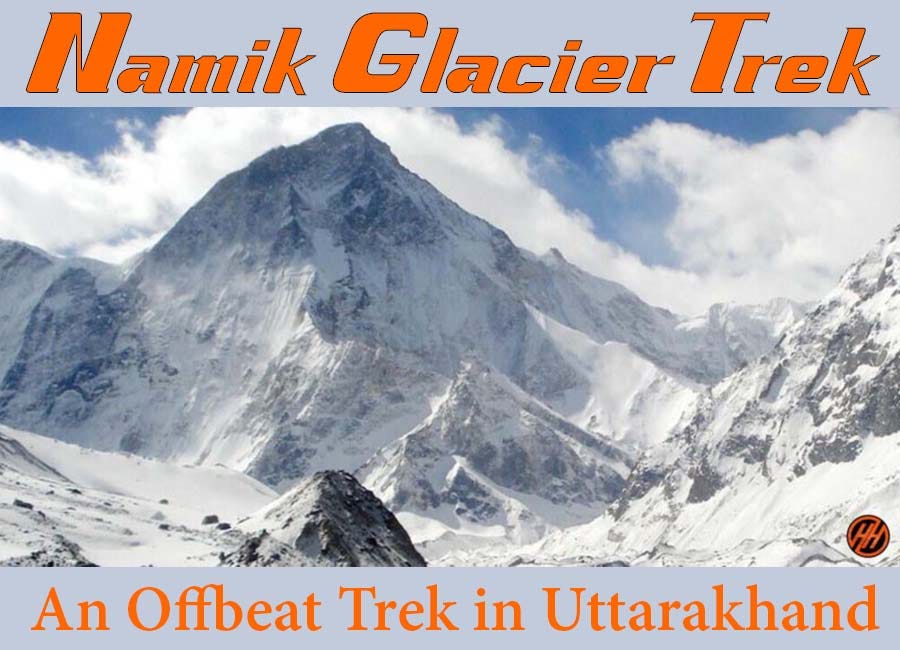Namik Glacier Trek — An Offbeat trek in Uttarakhand
Namik Glacier Trek — Perched in the isolated region of Kumaon, Namik Glacier lies at an altitude of 3,600 in the lap of Himalayas.
It is surrounded by some major Himalayan peaks in the world that are Mt. Trishul, Nanda Kot, and Nanda Devi.
Munsyari is the starting point of Namik Glacier trek. It is a hamlet with beautiful wide meadows and striking views of the Panchachuli range which makes it the most beautiful spot of Kumaon.
Namik Glacier is very famous because of the sulphur springs and waterfalls which originate from this region. The surroundings are extremely attractive and great for nature lovers.
Also Read About — Mt Kamet Expedition — The Second Highest Mountains in Uttarakhand, India.

Explore the isolated regions of Kumaon and get into the wilderness of Himalayas. Go through quaint Himalayan villages and peek into the local culture and visit sacred temples.
Namik village on the way was the center for Indian Tibetan trade. You can witness traditional structures and woodcarvings there.
On Namik Glacier trek pass through dense forests and beguiling meadows which follows the Rāmgangā River with the exotic sight of the Himalayas.
Why Choose Namik Glacier Trek?
It is a perfect offbeat trek offering thrilling adventure and tranquil surroundings.
Get close views of major Himalayan peaks in the world that are Mt. Trishul, Nanda Kot, and Nanda Devi.
The sulphur springs and waterfalls originate from here which is a great attraction of Namik glacier trek.
Namik on the way to Namik Glacier was the center for the Indian Tibetan trade. You can witness traditional structures and woodcarvings there.
Go through picturesque quaint villages and explore local culture and their heritage.
Rāmgangā River originates from Namik Glacier so the trail follows the river through dense forests and beguiling meadows with the exotic sight of Himalayas.
Things to Know about Namik Glacier Trek
The trek starts from Munsyari which is a beautiful hamlet and ahead is wide Senar Gad meadows and further, the trail follows Dhal auk, Sudam Khan, and Hirmani Glacier.
The hike to Hirmani glacier is adventurous and the camps are pitched on glacier’s margin. Finally, the trek ends at Namik Glacier.
Namik Glacier is 10 days challenging trek because of the long distance and uneven steep path. So, it is advised that only experienced trekkers and fit beginners go for it.
The best time to do Namik glacier trek is the months of May, June, September, and October. Choose this trek and get a chance to experience the isolated beauty of Himalayas.
Key Points of Namik Glacier Trek
Level: Easy to Moderate
Proper conditioning & training of body required
Need proper gear & clothing for sub-zero temperature?
Shoes are the single most important equipment.
High Altitude requires proper acclimatization.
Beautiful landscapes so carry good photo gear & Extra battery backup.
Travel light
The backpack should not exceed 10kgs.
Must Read about Namik Glacier Trek
Duration: 10 days (Kathgodam to Kathgodam)
Best Season: May, June, September, and October
Level: Easy to Moderate
Highest Point: (3,600 m)
Weather: Nights are cold and day temperature is pleasant according to Season.
Summer temperature: (5°C to 12°C)
Starting point: Kathgodam
Short Itinerary of Namik Glacier Trek
Day 1 — Drive from Kathgodam to Chaukori
Day 2 — Drive from Chaukori to Munsyari and trek to Senar Gad (07 km) (3/4 Hours)
Day 3 — Trek from Senar Gad to Dhaldauk (11 km) (5/6 Hours)
Day 4 — Trek from Dhaldauk to Sudamkhan (07 km) (4/5 Hours)
Day 5 — Trek from Sudamkhan to Hirmani Glacier (09 km) (4/5 Hours)
Day 6 — Trek from Hirmani Glacier to Namik Glacier and descent to Sudamkhan (14 km) (6/7 Hours)
Day 7 — Trek from Sudamkhan to Namik village (11 km) (5/6 Hours)
Day 8 — Trek from Namik village to Gogina (06 km) (3/4 Hours)
Day 9 — Trek from Gogina to Liti (16 km) (7/8 Hours)
Day 10 — Drive from Liti to Kathgodam via Bageshwar

Comments
Post a Comment